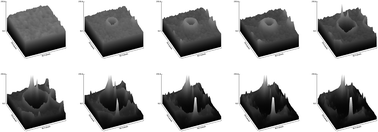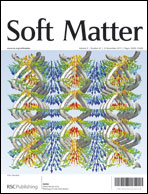Interaction of sphingomyelinase with sphingomyelin-containing supported membranes†
Abstract
We have studied the interaction of the enzyme sphingomyelinase with sphingomyelin-containing supported membranes using quantitative applications of real-time epifluorescence microscopy and imaging optical ellipsometry. The enzymatic action converts sphingomyelin into ceramides by cleaving the phosphodiester bond. Our results confirm previous studies establishing a gross morphological transformation of lipid bilayers involving a multi-step process consisting of lag-burst type of enzyme activation and in-plane reorganization of membrane components attributed to the formation of ceramide-enriched domains. A unique finding of our study is the evidence for the existence of an additional out-of-plane deformation following lateral reorganization resulting in membrane voids disrupting the laterally contiguous bilayer. Taken together, the in-plane and out-of-plane deformations suggest a mechanistic picture in which lateral diffusional processes of translational mobility and phase separation couple with out-of-plane interactions across the membrane leaflet to induce irreversible membrane disruption in response to SMase action. Remarkably, lipid monolayers supported on hydrophobic substrates exhibit no such large-scale deformation despite ceramide generation by enzymatic activity of sphingomyelinase, possibly suggesting the importance of coupling across membrane leaflets in inducing out-of-plane deformations.


 Please wait while we load your content...
Please wait while we load your content...